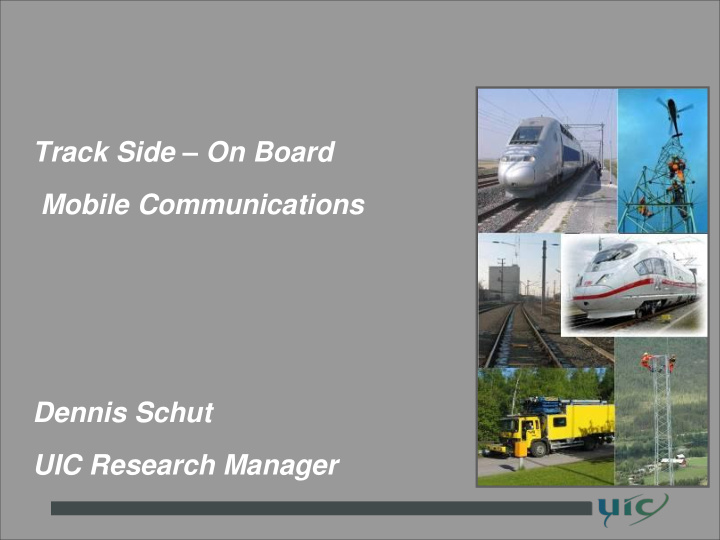



Track Side – On Board Mobile Communications Dennis Schut UIC Research Manager
Track Side – On Board Operational Communication In Europe, the radio system supporting track side-on - board communications is GSM-R, solution enforced by the European CCS TSI By operational communications we understand the support for vital data transmission needed for ETCS , and for voice application needed for the Train Radio – where train drivers, dispatchers and in some country cases maintenance teams are involved .
GSM-R is based on ETSI GSM > Based on standard GSM functionality and equipment – All GSM 2+ functionalities can Standard GSM functionality be used for GSM-R
GSM-R is an ETSI standard > Uses more GSM functionalities than public operators – Voice Group Call Service GSM enhancements – Voice Broadcast Service for railways (ETSI 3GPP) – Enhanced Multi Level Precedence and Pre-emption – All functionality can Standard GSM functionality be used for GSM-R
Additional Railway features – part of the TSI • Functionalities specified by the railways – Functional Numbering – Location Dependent Addressing Railway specific – Railway Emergency Calls Functionalities – High speed 500 km/h (EIRENE) – … – Voice Group Call Service GSM enhancements Voice Broadcast Service for railways (by ETSI) – Enhanced Multi Level Precedence and Pre-emption – All functionality can Standard GSM functionality be used for GSM-R
GSM-R National Features – e(enhanced) LDA – eREC – SMS to Functional Number /National – … Applications – Functional Numbering Railway specific – Location Dependent Addressing Functionalities – Railway Emergency Calls (EIRENE) – High speed 500 km/h – Voice Group Call Service GSM enhancements Voice Broadcast Service for railways (by ETSI) – Enhanced Multi Level Precedence and Pre-emption – All functionality can Standard GSM functionality be used for GSM-R
GSM-R Definition GSM GSM-R - GSM-R is a European Standard, developed by and for the + Railways, based on ETSI GSM 2+ (Release 99 and recently release 4 – being validated - It provides the features of a GSM network, plus ASCI ASCI (Advanced Call Speech Items) specific features for Railways operations and Railway Specific (EIRENE) + - It has dedicated radio spectrum for rail use, all over Europe - It is the bearer for ETCS, voice, and various data applications Railway Specific Features * Rail features for GSM-R - Dedicated Frequency Band (876-880 / 921-925 MHz) + - Priority and Preemption (eMLPP) - Functional Addressing (FN) Quality of Service - Location Depending Addressing (LDA, eLDA) - Voice Broadcast Calls (VBS) - Voice Group Calls (VGCS) - Fast Calls Set-up - Railway Emergency Calls (REC, eREC) GSM-R
GSM-R R App ppli lications ations ETCS Train Radio Data Voice calls, FN, LDA, REC… Shunting Point to Point, & Group Calls GSM-R Operati tional onal Voice Communi nication on for Railway ay Staff ff Point to Point, Group Calls, REC, Data Diagnostics, Energy Data, Train GSM-R Maintenance Data, SMS Back- up for GSM-R, One single Platform for Voice and Data
GSM-R Applications - ETCS - GSM-R is the bearer for ETCS. - GSM-R has to guarantee a high level of Quality of Service in order to fulfill the needs of ETCS. - ETCS requires critical real time interactive data transfer - if the Movement Authority (MA) is not available at the right time, the train will brake - Strictly telecom point of view, small messages are sent periodically or when required, both ways - For now, the TSI allows only Circuit Switched Transmission Mode
GSM-R QoS for ETCS GSM-R Quality of Service requirements for ETCS, defined in Subset 093 Subset 093 defines the ETCS requirements for GSM-R (TSI CCS, Annex A, informative section) - it is designed for Circuit Switch Transmission Mode Compared to voice applications, ETCS applications requires: • Stronger coverage • Fall back solutions (e.g. double coverage of Public Network Roaming) • Disaster Management
Narrow Band Critical A snapshot for the communications in the “train Applications environment”. Critically for Railway Operations Red means carried by Railways system Train Radio Blue means carried by railways or public ETCS systems Maintenance Teams Train Maintenance Broadband Wireless Driver Look Ahead; CCTV … Seat reservation Real time passenger information Mail, WEB Bandwidth
Train-Ground communications snapshot > The Mobile internet booming is visible also in Railway environment > Making a train-ground telecom applications snapshot, we will find: Operational communications (voice and data) – using the railway telecommunication system, Train & train crew related communications – train maintenance, train diagnostic, crew communications, security, catering, etc – using the railway or a parallel telecommunication system Passengers private communications – 3G modems, mobile phones – public mobile operators Lately Internet in Train – access to mail and limited internet, public operators in cooperation with the train operators, using Satellite transmissions, M-OFDM, leaking feeders technologies . Most of these aspects were covered in the UIC Final Report of the project E- Train, finalized in 2010
Train Communication Network > > As scope of the TCN – General architecture, it is noted that this part of IEC 61375 applies to the architecture of data communication systems in open trains, i.e. it covers the architecture of a communication system for the data communication between vehicles of the said open trains, the data communication within the vehicles and the data communication from train to the ground. > > As UIC is the Technical Body for radio standardization processes, there is a strong need that we are part of any discussion which takes into account track side – on board communications – applications, systems, requirements, etc, to make sure that compatibility with existing systems and requirements is ensured.
Thank You for Your Attention Dennis Schut – UIC - contact: schut@uic.org Dan Mandoc – UIC – contact: mandoc@uic.org
Recommend
More recommend